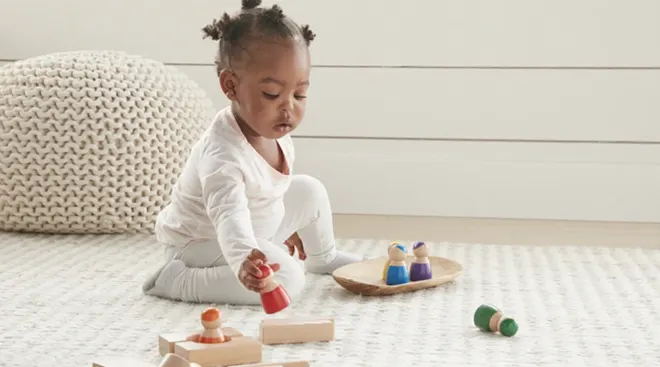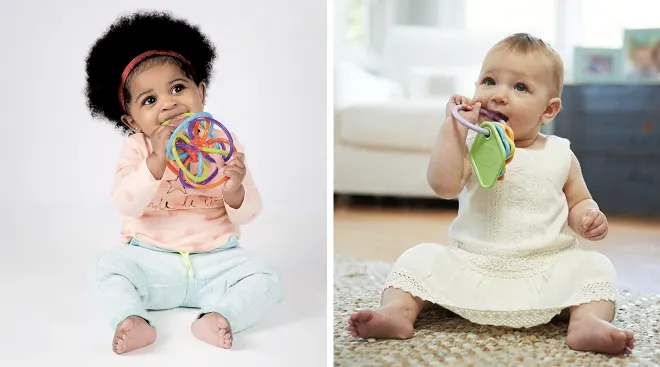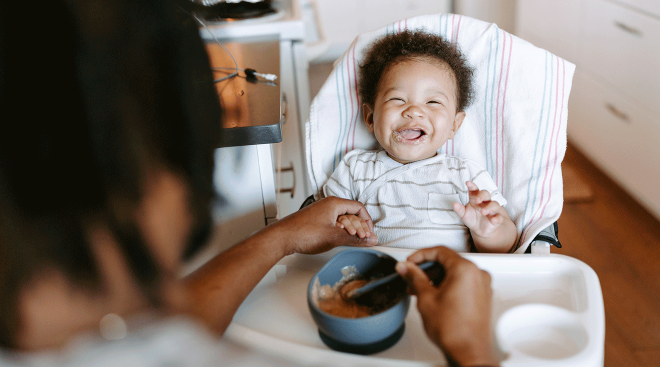5-Month-Old Baby

Baby is 5 months old! Feeling a bit like a coach these days? You’ve been giving baby tons of encouragement over the past month—as they’re (probably!) working on rolling over and trying to sit unassisted in a tripod position. Give baby the space to try on their own, but stay within arm’s reach, just in case they start to topple. You’re probably also inspiring baby’s language by having conversations around the house. The ultimate reward for all your efforts will be when you hear those wonderful words: "mama" and "dada".
It seems each day brings new 5-month-old baby milestones, and your little one has been practicing their motor skills and showing off their unique personality. As exciting as these moments are, you probably still have some questions surrounding this new stage. What can babies eat at the five-month mark? How can I keep my 5-month old busy? And perhaps most pressing: What time should a 5-month-old go to bed? (This whole early parenting thing is still very exhausting!)
Parenting has a nonstop learning curve, and we’re here to help. From understanding a 5-month-old baby’s feeding routine to structuring a (somewhat) normal 5-month-old sleep schedule, here’s what you need to know as you celebrate this age and stage.
- Baby’s starting to understand object permanence. To keep teaching them, you can play games like hiding an object and then revealing it.
- Sitting up unassisted is a big milestone baby’s working on tackling. By 6 months old, they’ll typically start to sit alone after being positioned upright.
- Baby’s getting more mobile—so it’s time to finish babyproofing your house.
You probably want to know: How much should my 5-month-old weigh? The average weight for a 5-month-old baby is 15.2 pounds for girls and 16.6 pounds for boys; the average length (aka height) is 25.2 inches for girls and 25.9 inches for boys.
Of course that doesn’t mean your 5-month-old should weigh and measure exactly that. Remember: Healthy babies tend to follow a natural growth curve, staying within the same percentile range as they grow older. As long as baby’s sticking to the curve, that’s an indicator of healthy growth. In any case, your child most likely gained about 1 to 1.25 pounds since last month!
You won’t typically hear the phrase “5-month-old growth spurt"—but it’s well known that babies tend to have growth spurts around the four- and six-month marks, and you’re right smack in the middle of those two. As we know, not every baby is exactly the same, so if you suspect yours is having a growth spurt—they’re extra hungry and feeding like crazy for a few days—then they probably are.
Your busy 5-month-old baby is working on a number of skills that’ll really come in handy for moving around and getting things done, and they’re getting bigger too. So what do 5-month-old babies do? Here’s an idea of what’s likely going on with yours this month:
- Baby’s eyesight is growing sharper by the day. So what can babies see at 5 months old? Babies at this age will start noticing things several feet away and can differentiate between colors. They can also focus on objects without crossing their eyes.
- Baby is fascinated by their hands and may have started bringing both of them together. (Patty-cake time!)
- They’re likely reaching with both hands, grasping things and holding them using all their fingers.
- Baby is starting to learn about object permanence. Hide an object and then reveal it, so baby will start to learn that things still exist even when they can't see them.
- Baby’s working on sitting up unassisted, and will typically be able to sit up after being positioned upright by the time they’re 6 months old. You can help baby with this skill by continuing to practice tummy time. You can also gently prop baby up, but make sure not to do this for too long to avoid tiring them out.
- They’ve either started rolling over or are swaying side-to-side, getting ready to reach this milestone. Average age to start to roll from tummy to back is 4 months old; after that, baby will start to roll back to their tummy. A 5-month-old not rolling over isn’t cause for concern, but if baby isn’t at least trying to roll by their six-month checkup, you should let the pediatrician know.
- For your 5-month-old, crawling may be on the horizon. Babies tend to start crawling between 7 to 10 months, but some especially determined babies get started earlier than that.
5-month-old sensory development
- Baby’s ability to distinguish between different colors is improving—it’s not just the bright, bold colors they can tell apart but now it’s pastels and other subtle hues too.
- Baby can now spot a toy just out of reach, and grab it. Go baby!
- Baby will turn their head to hear a rattling sound and may start to turn their head when they hear a voice.
- They’re listening to what you’re saying and may soon start to imitate your words. Once they’re making some sounds they like—“oh” or “ah” maybe—they might keep on repeating them. How cute!
“Apart from being able to raise their head, one of the first major motor milestones many babies reach is rolling over… Safety measures should be taken into consideration when baby starts to roll. Never leave them unattended on high surfaces like beds or changing tables.” — Richard Cabrera, MD, board-certified pediatrician, Torrance Memorial Medical Center in California
As your 5-month-old starts going out into the world more—perhaps going to daycare—you likely have some new questions about their health. Here are some topics you might want to know about this month:
Common illness exposure at daycare
The bad news: Babies in daycare are more likely to get sick. The good news: Fighting off these bugs might help them build a more resilient immune system, so they get sick less often in the future. Don’t be surprised if baby picks up a cold or flu, which could lead to an ear infection. Stomach viruses (like gastroenteritis), hand, foot and mouth disease and RSV are also common. Make sure to wipe down surfaces and keep up with hand hygiene.
RSV
For infants, this highly contagious and common virus is the number one cause of hospitalization. Fortunately, you can help protect baby. If you didn’t get the maternal RSV vaccine during your pregnancy, baby can be vaccinated if they’re under 8 months old. Plus, you can watch for symptoms like irritability or decreased drinking, especially during the cold months. Although RSV is usually mild and cold-like, it can develop into more serious conditions, like pneumonia. Call your provider if baby has trouble breathing or isn’t drinking enough.
Croup
If baby develops a barking cough or makes high-pitched whistling sounds, they could have croup. Usually resulting from a virus, this common condition causes baby’s voice box and windpipe to swell. When they do, the airway beneath the vocal cords narrows, making breathing noisier and more difficult. Although the sounds can be unnerving, rest assured croup usually goes away on its own. To keep your little one comfortable in the meantime, you can give them an age-appropriate dose of Infant Tylenol. You can also alternate steam (like having them stand by a steamy shower) with cool air (an open window) for 15 minutes each, which can help their airways. Call your provider if they’re struggling to breathe, continuing to breathe noisily or quickly despite treatment, or if their lips or nails turn blue.
Giving baby water
Until they’re a year old, breast milk or formula will provide baby with enough hydration. So hold off on giving your little one any water until they’re at least 6 months old.
Checkup and vaccines
Get ready for baby’s upcoming six-month checkup. At this visit, your pediatrician will perform a physical exam to make sure baby’s development is on track. They’ll also give your little one a new round of vaccines, which likely include third doses of Rotavirus, DTaP, Hib, PCV, IPV and HBV. Six months old is also the youngest age baby can receive the flu shot and the COVID-19 vaccine. Your provider might also suggest the MMR (measles, mumps and rubella) vaccine if baby is traveling abroad.
Feeding baby may be getting more complicated than it used to be. Nursing may have turned into nursing and pumping; bottles may have turned into bottles and baby food. Have no fear: We’ll clear it up for you. Here’s everything you need to know.
How much should a 5-month-old eat?
Wondering how much and how often a 5-month-old should eat? Five-month-old babies typically breastfeed or bottle-feed every three to four hours and may have started eating solid foods about two times per day.
- Breastfeeding: You should be nursing baby every three or four hours, but keep in mind that each breastfed baby is different. What’s important is that baby seems content, your boobs seem to have been emptied (they’re soft) and baby’s gaining weight steadily.
- Bottle-feeding: How much formula for a 5-month-old baby? Many babies this age eat 4 to 6 ounces of formula about four to six times a day.
- Pumping: If you’re pumping breast milk, you’re probably wondering how many ounces of breast milk for a 5-month-old is enough. Five-month-olds need about 25 ounces of breast milk per day. So you’ll need to divide that by how many feedings baby usually has. So if you feed baby about eight times per day, they should get about 4 ounces of breast milk at each feeding. That’s about how much milk a 5-month-old should drink. However, keep in mind that every baby is different and their feeding needs may vary.
To double-check that baby’s getting enough breast milk, you can check their diapers: Baby should be filling at least five a day.
What can babies eat at 5 months?
Five-month-old babies still need breast milk, formula or a combination of both. Does baby watch you intently—and maybe even reach for your food—while you eat your own breakfast? And do they have good head control? If so, it might be time to start your 5-month-old on solids.
Wondering how much baby food for a 5-month-old is recommended? The five-month mark is an exciting time as baby might be ready to take on solid foods. If you and your pediatrician have decided to move forward with baby solids, go slow and follow baby’s cues. You might start out with breast milk or formula, introduce a small teaspoon or two of a single-ingredient solid (like mashed bananas or avocados) and then finish with more breast milk or formula. The goal right now is to get baby comfortable with new flavors and textures.
How much fruit and veggies or how much rice cereal for a 5-month-old largely depends on the baby. The longer baby’s been eating solids and the more they’re interested in eating them, the more you should feel free to feed them—up to three ounces, three times per day.
Still in the throes of all-night wakings? It’s (unfortunately) completely normal at this age. Read on for some common solutions to get you and your 5-month-old sufficient shuteye.
5-month-old sleep schedule
Five-month-olds tend to sleep around 15 hours a day, including about up to 10 hours at night (some babies wake at night and others don’t!) and two or three naps, adding up to around five hours of daytime sleep. Experts generally recommend putting baby to bed for the night around 7 or 7:30 p.m., but ultimately this will depend on what works best for your family. The last nap should end ideally no later than 5 p.m. if they have an early bedtime.
If baby isn’t sleeping, it could be for a variety of reasons; one of the most common is sleep regression. The 5-month-old sleep regression is common because, at this age, babies naturally go through biological changes in their sleep cycles and begin to sleep less deeply. Plus, they’re going through rapid physical and cognitive development, and their brains have become more active. A soothing sleep routine can help baby get back to snoozing more soundly.
A 5-month-old is starting to take fewer naps, and perhaps go to bed earlier. Here’s a sample 5-month-old baby schedule:
As baby grows and develops each day, you’re probably wondering: How can I keep my 5-month old busy? Here are some fun activities to keep them engaged and entertained:
- Take baby for a walk. As their eyesight improves, baby will begin focusing on different aspects of nature, from trees to flying birds. This is great stimulation for baby; plus, a change of scenery and fresh air can be good for you too!
- Put baby on the floor to explore. Whether you put baby on their back or tummy, this floor time gives them a chance to move around, explore and strengthen those little muscles. (Just be sure to babyproof the area first).
- Play music. Baby’s hearing is getting better; they’ll love listening to different kinds of music. Sing along and dance with baby.
- Continue to read to baby. Reading every day will help encourage early language skills.
Here are some tips to keep in mind as you continue to recover—and baby continues to get bigger and more active.
Postpartum recovery tips
- Embrace self-care. Sure, you’ve recovered from the delivery and might have gotten the hang of having a baby. But odds are you’re still sleep-deprived and overwhelmed. Make sure to nourish yourself with a nutrient-rich diet and carve out time to exercise. When baby goes down for a nap, get some shuteye or—if you’ve got the energy—get some movement. Ask your partner to watch your little one so you can head to the gym or see a friend. And try to find ways to connect as a couple.
- Try energizing snacks. Although you might be tempted to reach for a high-caffeine or high-sugar snack, like a sweet coffee drink or a donut, try to resist (but, of course, don’t deprive yourself!). Either way, the burst of energy these treats offer won’t last. Instead, turn to foods with protein, fiber and complex carbohydrates. They’ll take longer to digest and deliver more stamina. Think a couple of hard-boiled eggs, a handful of edamame or a parfait with Greek yogurt, fresh berries and nuts. And don’t forget to drink lots of water, since dehydration can cause fatigue.
- Stay on top of your mental health. Baby milestones, getting less sleep and the general stress of postpartum life can get to you. Make sure to reach out to a mental health professional if you’re experiencing symptoms of postpartum anxiety or postpartum depression—but also if you want to just talk things out.
5-month-old baby care tips
- Prioritize bath safety. Baby bath time is fun—but it’s also serious business. Since babies can drown in as little as one inch of water, never leave your little one alone—even for a second. Before getting ready to bathe them, make sure you have all the supplies you need. Test the water to make sure it’s between 90 and 100 degrees F and empty the bath right after you finish.
- Continue to babyproof. Now that baby’s on the move (or about to be), it’s time to finish childproofing your home. If you haven’t already, install gates on stairways and operable window guards on all windows above the first floor. Anchor heavy furniture and TVs to the wall, cover the sharp corners of furniture with padding or bumpers, and remove any accessible choking hazards. Follow our babyproofing checklist to cover your bases.
- Brush baby’s budding teeth. As soon as baby’s teeth come in, it’s time to start brushing them. Repeat twice a day, in the morning and before bed. Use a small, soft-bristled toothbrush and moisten it with warm water. Then apply a small amount of baby toothpaste, the size of a grain of rice, and gently brush all tooth surfaces and wipe the remaining toothpaste away. Brushing helps remove bacteria and plaque from baby’s teeth. To make sure you clean them thoroughly, brush for about two minutes every time.
- Prioritize nap safety. Sure, it’s easier to let baby stay in their stroller or swing if they fall asleep. But it’s safest to gently transfer them to their crib or bassinet. That’s because baby sleep in swings has been linked to higher risks of injury, blocked airways, flat spots on heads and even death.
- Teach baby to be gentle with pets. The best way to show your little one how to treat the family pet is by example. For instance, show them how your cat prefers to be petted. Then, with pets you don’t know, let them see you ask the owner’s permission and wait for the animal to come to you before you pet them.
It’s exciting to have a 5-month-old—but it can also be really (really) hard. (We’re looking at you, sleep regression!) Let these stories from real parents inspire you on your own parenting adventure.
- Win: “What worked for us is that we had to teach her how to fall asleep on her own. We used to rock her or nurse her to sleep and she used a pacifier. When she was 5 months, we decided to let her cry it out. So we did the same bedtime routine that night and just put her down awake without her pacifier. She cried for about 20 minutes maybe. Now we do that for all her naps and bedtime, and it has really helped. Her naps extended and she dropped two night feedings!” — Jennyanydots26
- Challenge: “My daughter has been sleeping through the night for at least a month-and-a-half now. But the past few nights, she's been waking up fussing. It started with her waking up once. I'd give her the pacifier and she'd go right back to sleep. The past two nights though, she's up almost every hour. If she's not screaming, she’ll toss and turn all night long. It's like she can't get comfortable.” — Marie R
- Wisdom: “Definitely don't feel behind when it comes to starting solids—there’s no rush! We just started veggies (just peas so far and she’s 5.5 months) and haven't started fruits yet (will probably wait until at least 6 months). Right now, I'm doing some cereal in-between her first and second bottle. She gets a bottle when she wakes up, eats some cereal about an hour-and-a-half later and then takes a nap. She then takes a bottle when she wakes up from that nap. Then I do cereal and veggie around dinner time, which is about an hour or so before her bedtime bottle. Don't know if this is ‘right’ but it works for us!” — laur1120
“When my girls were 5 months old, I wouldn’t dare leave the house without a well-packed diaper bag. My best tips are to use a diaper bag checklist and not to forget to pack things for yourself too. You can make your own checklist or find plenty of free printables online. I never trusted myself to remember everything in my sleep-deprived state… Don’t forget to pack a change of clothes for yourself in case of a spit-up mishap or if you’re a nursing mama and leaks happen.” — Sierrah Schmidt, mom of three, upstate New York
Frequently Asked Questions
Is it normal for my 5-month-old to start teething?
Yes, babies can develop their first tooth as early as 4 months old. When they do, expect lots of drooling plus some irritability. If baby’s uncomfortable, you can give them something safe to chew on—like a cool rag or firm rubber toy. If baby’s still cranky, you can try some Infant Tylenol. The FDA recommends steering clear of homeopathic teething tablets, medications with benzocaine and amber teething necklaces.
What are the key tips for traveling with a 5-month-old?
There are plenty of tips for traveling with baby that will make your experience a bit easier. Here are a few things to consider: Try to travel around baby’s schedule—naptime and all—if possible. It’ll make for a less cranky baby.
Bring baby’s essentials: lots of extra clothes and diapers, a first-aid kit, bottles and/or breastfeeding accessories—and (perhaps most important!) plenty of toys to keep baby entertained. Go over the logistics beforehand: Do the research on travel, passport and visa requirements, as well as vaccines baby may need. Get to the airport or train station a little earlier than you think you might have to.
When flying, remember that you can take breast milk, formula and baby food (like puree pouches) in quantities larger than 3.4 ounces in your carry-on, as well as cooling accessories like freezer packs and gel packs. Keep in mind that these might require additional screening; make sure to put these in a separate bag so things go smoother.
Takeoff and landing can be difficult for baby due to their sensitive ears: You can help them by letting them nurse, or suck on a bottle or pacifier, to ease things a bit.
Although airlines generally allow you to have a baby or toddler under 2 years old on your lap while flying, the Federal Aviation Administration (FAA) strongly urges you to use a car seat for safety reasons. The American Academy of Pediatrics (AAP) recommends getting baby their own seat with a car seat that’s certified for airplane use. Check in with your airline about rules and regulations.
If you’re road-tripping, make sure baby is safe and secure in a properly installed car seat. Take breaks every few hours to feed and change baby—and keep them from getting too restless.
What are the safest toys for a 5-month-old?
Since babies this age tend to put everything in their mouth, stay away from choking hazards and anything made with toxic materials. Instead, opt for larger toys made of wood, natural rubber or food-grade silicone. Since your little one should now be able to see in full color and respond to faces, they’ll likely appreciate brightly hued objects and a child-friendly mirror. They’ll probably also reach for teething rings, since their first tooth should come in soon (if it hasn’t already). Other safe toys for a 5-month-old include an activity center, board books, a toy piano and interactive stuffed animals. Let the playtime begin!
What should I do if baby hates tummy time?
It’s normal for baby to find tummy time frustrating—especially as they’re hard at work on milestones like rolling and sitting up. But it’s important not to skip this activity, which helps strengthen their neck and arm muscles. To make tummy time more pleasant, try it when they’re well-rested, like after their naps. Get down on the floor with them, holding a toy in front of their face. If they’re struggling, try placing a rolled-up towel or nursing pillow under their chest or positioning them on your chest instead of the floor.
What home cleaning supplies are safe to use around baby?
When exposed to harmful chemicals in some cleaning products, babies can experience respiratory irritation and rashes. So, seek out non-toxic options; these labels often include certifications or seals (like the EcoLogo seal). Also read ingredient lists, looking for natural ingredients like white vinegar and baking soda. Meanwhile, try to avoid products with ammonia, chlorine bleach and sodium lauryl sulfate. Also make sure to store all cleaning supplies out of reach of your little one.
How can I interpret baby’s different cries?
If only baby could talk! But for now, their primary method of communication is crying, which can mean anything from hunger to fatigue to discomfort. To interpret their cries, look for nonverbal cues. For instance, if they’re hungry, they might also be smacking their lips, chewing their hand or moving their head. If they have gas, they might also be making a sour face, pulling their legs to their chest, squirming their body or straining as if they’re having a bowel movement. Look for other clues too: Maybe their diaper needs to be changed; or their ears and nose feel cold, showing they could use another layer of clothing. If their chest and the back of their neck feel warm, try removing a layer of clothing and taking their temperature. Still coming up empty? Do a quick body check to make sure they don’t have a rash, injury or hair tourniquet. Then, try holding them, giving them a pacifier or putting them down for a nap.
Five-month-olds grow up right before your eyes. Your little one will surprise you each day with their new milestones. Their personality is getting more defined by the minute, and you’ll soon have a bubbly 6-month-old on your hands. Where has the time gone?
Please note: The Bump and the materials and information it contains are not intended to, and do not constitute, medical or other health advice or diagnosis and should not be used as such. You should always consult with a qualified physician or health professional about your specific circumstances.
Navigate forward to interact with the calendar and select a date. Press the question mark key to get the keyboard shortcuts for changing dates.













































